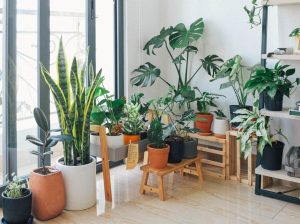
Plants can add to an otherwise monotonous office environment, a great deal of organic character. They can convert your workspace into a more
tranquil, and
stimulating environment, but your lovely new indoor plants could suffer an untimely end if you’re not very green-thumbed. Introducing plants may be the missing connection to nature required to
boost job productivity and happiness. Office plants can
increase the humidity around the office,
eliminate air toxins, and
improve the indoor air quality while providing a
focal point to the workplace.
Larger indoor plants such as Ficus Benjamina, Jade Plant, or Yucca could also be used to create helpful demarcations between workspaces and can also provide for a source of quiet contemplation on a hectic day. Having indoor plants around your office offers so many advantages. It can be difficult, however, to know which types of indoor plants are appropriate for specific indoor conditions, plus how to care for them properly. Fortunately, we’ve compiled for you a list of the best indoor plants you can get your hands on in Dubai along with their minimal needs.
The Jade Plant (Crassula Ovata)
It’s both a tree and a succulent! A combination that couldn’t be easier to care for!
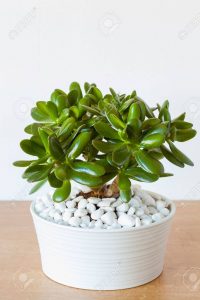
♦ The jade plant has fleshy, oval-shaped leaves and thick, woody stems that resemble tiny tree trunks. It can grow to a size of 60-90cm tall, but is slow-growing, growing only about two inches a year.
♦ Young jade plants should only be exposed to bright, indirect light to prevent leaf scorching. But mature ones can tolerate and thrive with up to 4 hours of direct sunlight or even partial shade.
♦ During the summer and spring, jade plants should be watered so the soil is kept moist but not wet. Reduce watering to monthly in the winter. Drainage is of utmost importance for good growth.
♦ Jade plants prefer normal room temperatures of about 22°C but at night and in the winter, jade plants prefer a cooler environment.
The Peace Lily (Spathiphyllum)
A favorite for those with and without a green thumb as it is a forgiving low maintenance plant. Also recommended by NASA for being one of the top ten Air Cleaning Plants.
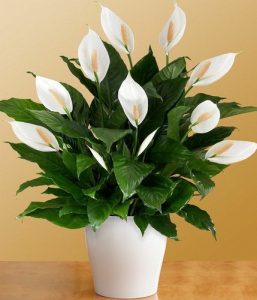
♦ The white blooms of the peace lily generally appear in the spring. Blooms last for two months or more and after the blooms fade, a period of non-blooming follows. They can grow up to 60-105cm tall.
♦ Peace lilies prefer light partial shade and can tolerate fluorescent lights. In fact, they have been known to thrive in rooms with no windows at all!
♦ When it comes to watering, it’s best not to stick to a schedule because Peace Lilies are not very demanding, just check the soil once a week and if the soil seems dry, only then indulge in watering your Peace Lily.
♦ Peace lilies are a tropical plant, so keep them in temperatures above 16°C. They do best in temperatures upwards of 21°C.
Chinese Evergreen (Aglaonema Overig)
Chinese Evergreens make a great office plant as it requires very little maintenance. It can also thrive in low light and remove toxins from the air.
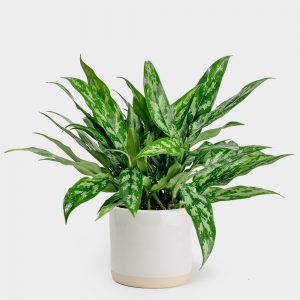
♦ Aglaonema’s leaves offer fantastic colors with delicate markings. The pale green versions are the best-known, but is also available with a silver, yellow and red tinge. They can grow up to 95cm in height.
♦ With Chinese Evergreens the darker the leaves and stalks, the less light is needed. A bright room with the plant sitting in a shaded spot is best. Avoid direct sunlight.
♦ They have low water needs, just make sure that the soil is always damp or moist. Needs to be watered approximately once a week.
♦ These plants prefer temperatures no lower than 16°C, with an average indoor temperature of around 22°C being most favorable, but if needed they can also tolerate temperatures between 10-13°C.
Kentia Palm (Howea forsteriana)
If you love the tropical look and feel, then the Kentia Palm is perfect for you! They are also notorious for being able to withstand conditions that many houseplants can’t tolerate.
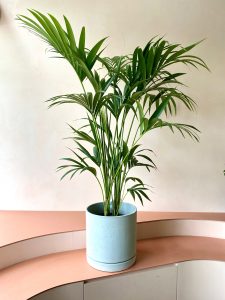
♦ Kentia palms have the typical large palm-shaped leaves. They can grow up to 12m in height but they are slow growers, and indoor Kentia palms typically max out in containers at fewer than 3.6m.
♦ They are quite forgiving and tolerate low light conditions, but do prefer areas that receive indirect light. You can also keep your Kentia outdoors during the warmer months in a somewhat shaded location.
♦ Kentia palms are fairly drought tolerant, although they do not like to be overly dry. Only water the top few inches when the soil starts to dry out.
♦ They can tolerate temperatures down to 13°C and up to 38°C, it is best to bring the plant indoors before winter and protect from excessive heat during the summer – no direct sun.
Snake plant (Sansevieria Trifasciata)
Sansevieria is easy to grow and is nearly indestructible; they will thrive in either very bright light or almost dark corners of the house.

♦ Snake Plants usually have green banded leaves, while the variety commonly known as Mother-In-Law’s Tongue typically features a yellow border. Grows up to 0.5–1.0m tall with a 30-60cm spread.
♦ Sansevieria prefers indirect light with some direct sun. They can adapt to full sun conditions and will also survive quite dim situations.
♦ Let the soil dry between waterings. It is better to underwater since too much water is one of the very few ways to kill the plant.
♦ They prefer warm conditions and will suffer if exposed to temperatures below 13°C. A temperature range of 21-32°C is ideal.
Song Of India (Dracaena Reflexa)
Dracaena Reflexa is a houseplant native to islands in the Indian Ocean. The name is derived from the Greek term Drakaina or “Female Dragon” because of a red gum-like resin in the stems, that was compared to dragon blood.

♦ The Dracaena Reflexa, Song of India, has yellow stripes on the leaves, while the Dracaena Reflexa, Song of Jamaica, has off white stripes on the leaves. They can range from 60-120 cm tall.
♦ In medium light, Dracaena Reflexa’s with dark green leaves do well. The Song of India and the Song of Jamaica, however, need bright, indirect light. Avoid direct sunlight for all varieties.
♦ The Reflexa, like many other Dracaenas, prefers to be kept on the dry side. Before watering, we would recommend allowing the top of the soil to dry out. And whenever you do water, water just so that water flows out of the drip holes at the bottom.
♦ Normal household temperatures between 18°-30°C are ideal.
Spider Plant (Chlorophytum Comosum)
The spider plant is so named because of its spider-like plants, or spiderettes, which dangle down from the mother plant like spiders on a web.

♦ These easy-to-grow houseplants look especially nice in a hanging basket and were a favorite in Victorian-era households. They grow quickly to 2-2.5 ft. wide & 2-3 ft. long when grown in a hanging basket.
♦ To maintain their stripes, all the variegated spider plants require a bright spot. A darker spot will do for the all green variety. Avoid direct sunlight.
♦ Water well during the summer but only moderately during the winter as growth tends to slow down. Make sure to plant them in a pot with drain holes to avoid root rot.
♦ The average warmth of a typical home is the key to good growth for a spider plant.
Weeping Fig (Ficus Benjamina)
Weeping fig is an elegant plant with slender branches that arch gracefully from a light gray trunk, with dense, glossy dark leaves that may shed when the plant is stressed.
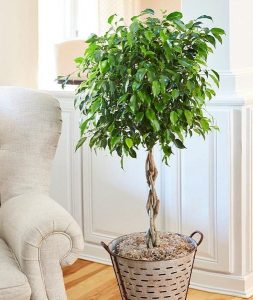
♦ The Weeping Fig gets even more attractive when the flexible trunk is braided to create an awesome decorative look. When grown indoors, they pruned to keep them between 5-10 ft. but can grow up to 40 ft. when grown outdoors.
♦ A nice spot with bright indirect light that is partially shaded keeps them happy and somewhere with enough space for height and width growth.
♦ Keep the soil of the plant moist and make sure your watering schedule is consistent. Overwatering or underwatering may cause the leaves to drop.
♦ Room temperatures of around 16°C -24°C are ideal. Try not to allow temperatures to go lower than 10°C. As tropical trees they also prefer an environment with higher humidity.
Devil’s Ivy (EPIPREMNUM AUREUM)
Epipremnum Aureum commonly also called Golden Pothos or Devil’s Ivy is native to the Solomon Islands. It is a climbing vine that produces abundant yellow-marbled foliage.
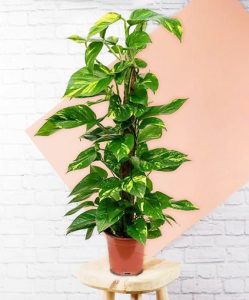
♦ Pothos are extremely easy to grow and are a popular house plant well known for its long, trailing stems. They can grow up to a height of 6 ft. with the proper support structure.
♦ Low to bright indirect light and no direct sun, which will burn foliage. Although they can tolerate low light, it will have more leaves and better variegation if kept in bright light.
♦ Allow the top 1” of soil to dry between waterings. Overwatering will cause root rot and leaves to turn yellow and fall off. Under-watering isn’t a big issue as they will withstand a high degree of abuse.
♦ Temperatures between 15-29°C year-round are perfect to keep this plant healthy. It will withstand temperatures down.
Swiss cheese plant (Monstera deliciosa)
Monsteras are famous for their natural leaf-holes and has led to the rise of its nickname, Swiss Cheese Plant.
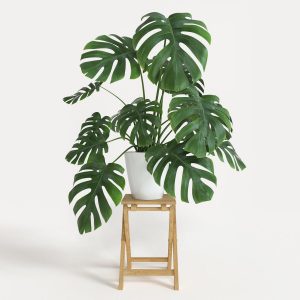
♦ The name, as you might guess, comes from the Latin meaning “abnormal” because of its peculiar, perforated leaves. In your home, they can reach about eight feet in height. Their leaves alone can measure up to 2 ft. long.
♦ Loves to be in bright to medium indirect light, but will be happy under fluorescent lights as well. Not suited for intense, direct sun.
♦ Water every 1-2 weeks, allowing the soil to dry out between waterings. Increase the frequency with increased light.
♦ The temperature in the room should stay between 18-27°C with average to high humidity.
If your organization could benefit from a boost when it comes to indoor plants, for your staff, and around the office, contact us at Plantscapes to explore your options for indoor landscaping.
 Plants can add to an otherwise monotonous office environment, a great deal of organic character. They can convert your workspace into a more tranquil, and stimulating environment, but your lovely new indoor plants could suffer an untimely end if you’re not very green-thumbed. Introducing plants may be the missing connection to nature required to boost job productivity and happiness. Office plants can increase the humidity around the office, eliminate air toxins, and improve the indoor air quality while providing a focal point to the workplace.
Larger indoor plants such as Ficus Benjamina, Jade Plant, or Yucca could also be used to create helpful demarcations between workspaces and can also provide for a source of quiet contemplation on a hectic day. Having indoor plants around your office offers so many advantages. It can be difficult, however, to know which types of indoor plants are appropriate for specific indoor conditions, plus how to care for them properly. Fortunately, we’ve compiled for you a list of the best indoor plants you can get your hands on in Dubai along with their minimal needs.
Plants can add to an otherwise monotonous office environment, a great deal of organic character. They can convert your workspace into a more tranquil, and stimulating environment, but your lovely new indoor plants could suffer an untimely end if you’re not very green-thumbed. Introducing plants may be the missing connection to nature required to boost job productivity and happiness. Office plants can increase the humidity around the office, eliminate air toxins, and improve the indoor air quality while providing a focal point to the workplace.
Larger indoor plants such as Ficus Benjamina, Jade Plant, or Yucca could also be used to create helpful demarcations between workspaces and can also provide for a source of quiet contemplation on a hectic day. Having indoor plants around your office offers so many advantages. It can be difficult, however, to know which types of indoor plants are appropriate for specific indoor conditions, plus how to care for them properly. Fortunately, we’ve compiled for you a list of the best indoor plants you can get your hands on in Dubai along with their minimal needs.
 ♦ The jade plant has fleshy, oval-shaped leaves and thick, woody stems that resemble tiny tree trunks. It can grow to a size of 60-90cm tall, but is slow-growing, growing only about two inches a year.
♦ Young jade plants should only be exposed to bright, indirect light to prevent leaf scorching. But mature ones can tolerate and thrive with up to 4 hours of direct sunlight or even partial shade.
♦ During the summer and spring, jade plants should be watered so the soil is kept moist but not wet. Reduce watering to monthly in the winter. Drainage is of utmost importance for good growth.
♦ Jade plants prefer normal room temperatures of about 22°C but at night and in the winter, jade plants prefer a cooler environment.
♦ The jade plant has fleshy, oval-shaped leaves and thick, woody stems that resemble tiny tree trunks. It can grow to a size of 60-90cm tall, but is slow-growing, growing only about two inches a year.
♦ Young jade plants should only be exposed to bright, indirect light to prevent leaf scorching. But mature ones can tolerate and thrive with up to 4 hours of direct sunlight or even partial shade.
♦ During the summer and spring, jade plants should be watered so the soil is kept moist but not wet. Reduce watering to monthly in the winter. Drainage is of utmost importance for good growth.
♦ Jade plants prefer normal room temperatures of about 22°C but at night and in the winter, jade plants prefer a cooler environment.
 ♦ The white blooms of the peace lily generally appear in the spring. Blooms last for two months or more and after the blooms fade, a period of non-blooming follows. They can grow up to 60-105cm tall.
♦ Peace lilies prefer light partial shade and can tolerate fluorescent lights. In fact, they have been known to thrive in rooms with no windows at all!
♦ When it comes to watering, it’s best not to stick to a schedule because Peace Lilies are not very demanding, just check the soil once a week and if the soil seems dry, only then indulge in watering your Peace Lily.
♦ Peace lilies are a tropical plant, so keep them in temperatures above 16°C. They do best in temperatures upwards of 21°C.
♦ The white blooms of the peace lily generally appear in the spring. Blooms last for two months or more and after the blooms fade, a period of non-blooming follows. They can grow up to 60-105cm tall.
♦ Peace lilies prefer light partial shade and can tolerate fluorescent lights. In fact, they have been known to thrive in rooms with no windows at all!
♦ When it comes to watering, it’s best not to stick to a schedule because Peace Lilies are not very demanding, just check the soil once a week and if the soil seems dry, only then indulge in watering your Peace Lily.
♦ Peace lilies are a tropical plant, so keep them in temperatures above 16°C. They do best in temperatures upwards of 21°C.
 ♦ Aglaonema’s leaves offer fantastic colors with delicate markings. The pale green versions are the best-known, but is also available with a silver, yellow and red tinge. They can grow up to 95cm in height.
♦ With Chinese Evergreens the darker the leaves and stalks, the less light is needed. A bright room with the plant sitting in a shaded spot is best. Avoid direct sunlight.
♦ They have low water needs, just make sure that the soil is always damp or moist. Needs to be watered approximately once a week.
♦ These plants prefer temperatures no lower than 16°C, with an average indoor temperature of around 22°C being most favorable, but if needed they can also tolerate temperatures between 10-13°C.
♦ Aglaonema’s leaves offer fantastic colors with delicate markings. The pale green versions are the best-known, but is also available with a silver, yellow and red tinge. They can grow up to 95cm in height.
♦ With Chinese Evergreens the darker the leaves and stalks, the less light is needed. A bright room with the plant sitting in a shaded spot is best. Avoid direct sunlight.
♦ They have low water needs, just make sure that the soil is always damp or moist. Needs to be watered approximately once a week.
♦ These plants prefer temperatures no lower than 16°C, with an average indoor temperature of around 22°C being most favorable, but if needed they can also tolerate temperatures between 10-13°C.
 ♦ Kentia palms have the typical large palm-shaped leaves. They can grow up to 12m in height but they are slow growers, and indoor Kentia palms typically max out in containers at fewer than 3.6m.
♦ They are quite forgiving and tolerate low light conditions, but do prefer areas that receive indirect light. You can also keep your Kentia outdoors during the warmer months in a somewhat shaded location.
♦ Kentia palms are fairly drought tolerant, although they do not like to be overly dry. Only water the top few inches when the soil starts to dry out.
♦ They can tolerate temperatures down to 13°C and up to 38°C, it is best to bring the plant indoors before winter and protect from excessive heat during the summer – no direct sun.
♦ Kentia palms have the typical large palm-shaped leaves. They can grow up to 12m in height but they are slow growers, and indoor Kentia palms typically max out in containers at fewer than 3.6m.
♦ They are quite forgiving and tolerate low light conditions, but do prefer areas that receive indirect light. You can also keep your Kentia outdoors during the warmer months in a somewhat shaded location.
♦ Kentia palms are fairly drought tolerant, although they do not like to be overly dry. Only water the top few inches when the soil starts to dry out.
♦ They can tolerate temperatures down to 13°C and up to 38°C, it is best to bring the plant indoors before winter and protect from excessive heat during the summer – no direct sun.
 ♦ Snake Plants usually have green banded leaves, while the variety commonly known as Mother-In-Law’s Tongue typically features a yellow border. Grows up to 0.5–1.0m tall with a 30-60cm spread.
♦ Sansevieria prefers indirect light with some direct sun. They can adapt to full sun conditions and will also survive quite dim situations.
♦ Let the soil dry between waterings. It is better to underwater since too much water is one of the very few ways to kill the plant.
♦ They prefer warm conditions and will suffer if exposed to temperatures below 13°C. A temperature range of 21-32°C is ideal.
♦ Snake Plants usually have green banded leaves, while the variety commonly known as Mother-In-Law’s Tongue typically features a yellow border. Grows up to 0.5–1.0m tall with a 30-60cm spread.
♦ Sansevieria prefers indirect light with some direct sun. They can adapt to full sun conditions and will also survive quite dim situations.
♦ Let the soil dry between waterings. It is better to underwater since too much water is one of the very few ways to kill the plant.
♦ They prefer warm conditions and will suffer if exposed to temperatures below 13°C. A temperature range of 21-32°C is ideal.
 ♦ The Dracaena Reflexa, Song of India, has yellow stripes on the leaves, while the Dracaena Reflexa, Song of Jamaica, has off white stripes on the leaves. They can range from 60-120 cm tall.
♦ In medium light, Dracaena Reflexa’s with dark green leaves do well. The Song of India and the Song of Jamaica, however, need bright, indirect light. Avoid direct sunlight for all varieties.
♦ The Reflexa, like many other Dracaenas, prefers to be kept on the dry side. Before watering, we would recommend allowing the top of the soil to dry out. And whenever you do water, water just so that water flows out of the drip holes at the bottom.
♦ Normal household temperatures between 18°-30°C are ideal.
♦ The Dracaena Reflexa, Song of India, has yellow stripes on the leaves, while the Dracaena Reflexa, Song of Jamaica, has off white stripes on the leaves. They can range from 60-120 cm tall.
♦ In medium light, Dracaena Reflexa’s with dark green leaves do well. The Song of India and the Song of Jamaica, however, need bright, indirect light. Avoid direct sunlight for all varieties.
♦ The Reflexa, like many other Dracaenas, prefers to be kept on the dry side. Before watering, we would recommend allowing the top of the soil to dry out. And whenever you do water, water just so that water flows out of the drip holes at the bottom.
♦ Normal household temperatures between 18°-30°C are ideal.
 ♦ These easy-to-grow houseplants look especially nice in a hanging basket and were a favorite in Victorian-era households. They grow quickly to 2-2.5 ft. wide & 2-3 ft. long when grown in a hanging basket.
♦ To maintain their stripes, all the variegated spider plants require a bright spot. A darker spot will do for the all green variety. Avoid direct sunlight.
♦ Water well during the summer but only moderately during the winter as growth tends to slow down. Make sure to plant them in a pot with drain holes to avoid root rot.
♦ The average warmth of a typical home is the key to good growth for a spider plant.
♦ These easy-to-grow houseplants look especially nice in a hanging basket and were a favorite in Victorian-era households. They grow quickly to 2-2.5 ft. wide & 2-3 ft. long when grown in a hanging basket.
♦ To maintain their stripes, all the variegated spider plants require a bright spot. A darker spot will do for the all green variety. Avoid direct sunlight.
♦ Water well during the summer but only moderately during the winter as growth tends to slow down. Make sure to plant them in a pot with drain holes to avoid root rot.
♦ The average warmth of a typical home is the key to good growth for a spider plant.
 ♦ The Weeping Fig gets even more attractive when the flexible trunk is braided to create an awesome decorative look. When grown indoors, they pruned to keep them between 5-10 ft. but can grow up to 40 ft. when grown outdoors.
♦ A nice spot with bright indirect light that is partially shaded keeps them happy and somewhere with enough space for height and width growth.
♦ Keep the soil of the plant moist and make sure your watering schedule is consistent. Overwatering or underwatering may cause the leaves to drop.
♦ Room temperatures of around 16°C -24°C are ideal. Try not to allow temperatures to go lower than 10°C. As tropical trees they also prefer an environment with higher humidity.
♦ The Weeping Fig gets even more attractive when the flexible trunk is braided to create an awesome decorative look. When grown indoors, they pruned to keep them between 5-10 ft. but can grow up to 40 ft. when grown outdoors.
♦ A nice spot with bright indirect light that is partially shaded keeps them happy and somewhere with enough space for height and width growth.
♦ Keep the soil of the plant moist and make sure your watering schedule is consistent. Overwatering or underwatering may cause the leaves to drop.
♦ Room temperatures of around 16°C -24°C are ideal. Try not to allow temperatures to go lower than 10°C. As tropical trees they also prefer an environment with higher humidity.
 ♦ Pothos are extremely easy to grow and are a popular house plant well known for its long, trailing stems. They can grow up to a height of 6 ft. with the proper support structure.
♦ Low to bright indirect light and no direct sun, which will burn foliage. Although they can tolerate low light, it will have more leaves and better variegation if kept in bright light.
♦ Allow the top 1” of soil to dry between waterings. Overwatering will cause root rot and leaves to turn yellow and fall off. Under-watering isn’t a big issue as they will withstand a high degree of abuse.
♦ Temperatures between 15-29°C year-round are perfect to keep this plant healthy. It will withstand temperatures down.
♦ Pothos are extremely easy to grow and are a popular house plant well known for its long, trailing stems. They can grow up to a height of 6 ft. with the proper support structure.
♦ Low to bright indirect light and no direct sun, which will burn foliage. Although they can tolerate low light, it will have more leaves and better variegation if kept in bright light.
♦ Allow the top 1” of soil to dry between waterings. Overwatering will cause root rot and leaves to turn yellow and fall off. Under-watering isn’t a big issue as they will withstand a high degree of abuse.
♦ Temperatures between 15-29°C year-round are perfect to keep this plant healthy. It will withstand temperatures down.
 ♦ The name, as you might guess, comes from the Latin meaning “abnormal” because of its peculiar, perforated leaves. In your home, they can reach about eight feet in height. Their leaves alone can measure up to 2 ft. long.
♦ Loves to be in bright to medium indirect light, but will be happy under fluorescent lights as well. Not suited for intense, direct sun.
♦ Water every 1-2 weeks, allowing the soil to dry out between waterings. Increase the frequency with increased light.
♦ The temperature in the room should stay between 18-27°C with average to high humidity.
If your organization could benefit from a boost when it comes to indoor plants, for your staff, and around the office, contact us at Plantscapes to explore your options for indoor landscaping.
♦ The name, as you might guess, comes from the Latin meaning “abnormal” because of its peculiar, perforated leaves. In your home, they can reach about eight feet in height. Their leaves alone can measure up to 2 ft. long.
♦ Loves to be in bright to medium indirect light, but will be happy under fluorescent lights as well. Not suited for intense, direct sun.
♦ Water every 1-2 weeks, allowing the soil to dry out between waterings. Increase the frequency with increased light.
♦ The temperature in the room should stay between 18-27°C with average to high humidity.
If your organization could benefit from a boost when it comes to indoor plants, for your staff, and around the office, contact us at Plantscapes to explore your options for indoor landscaping.


